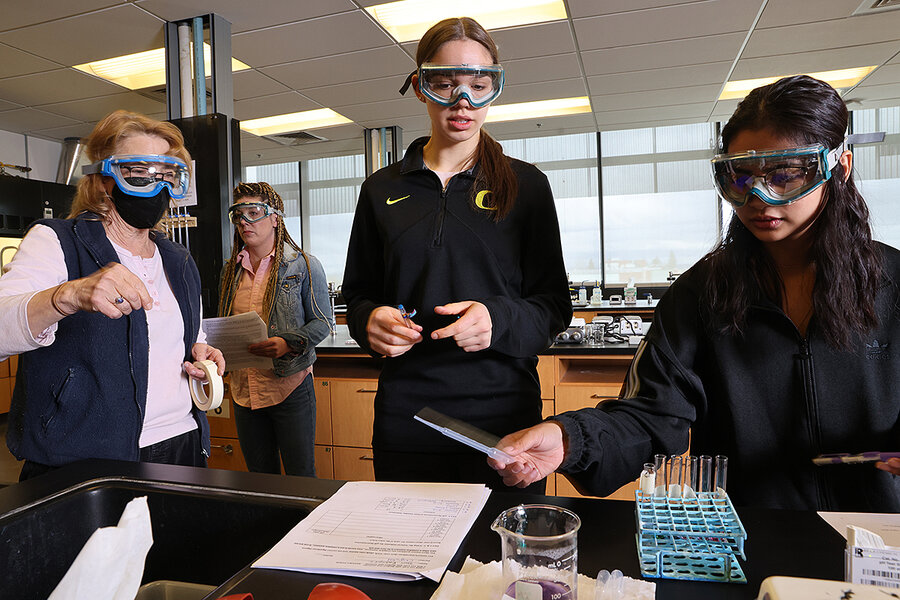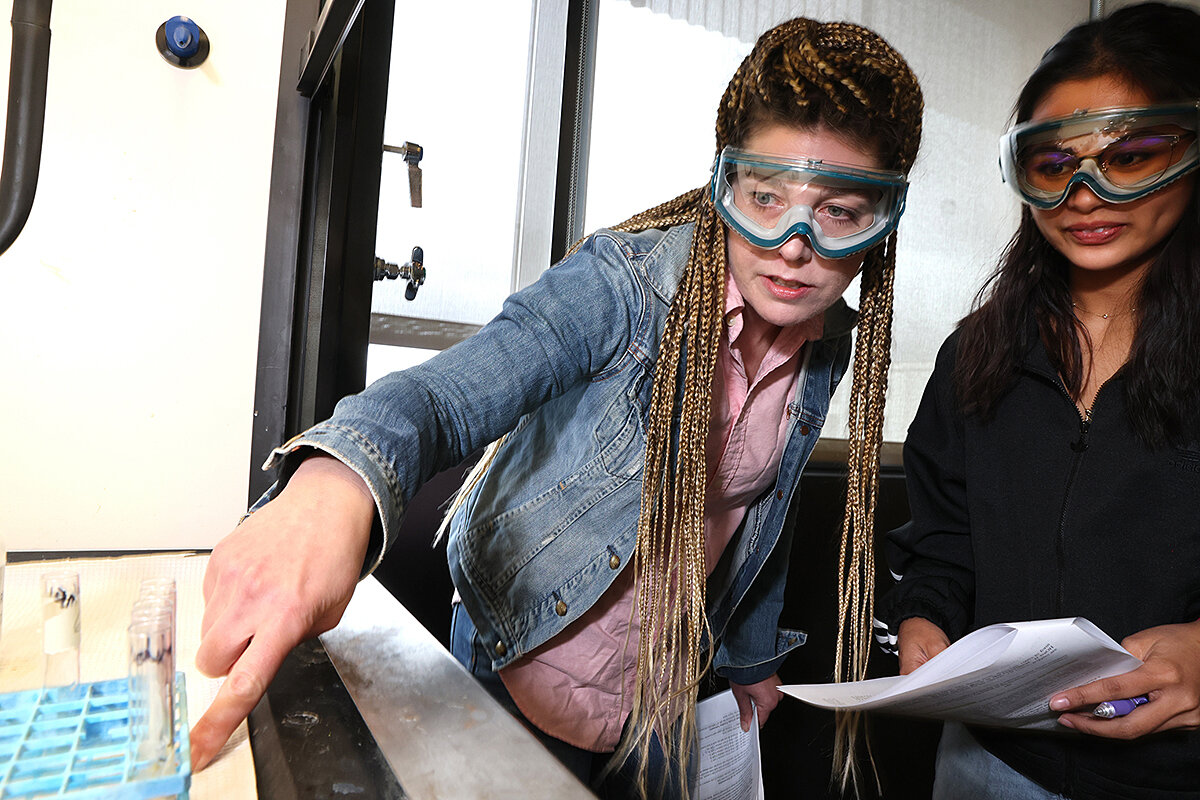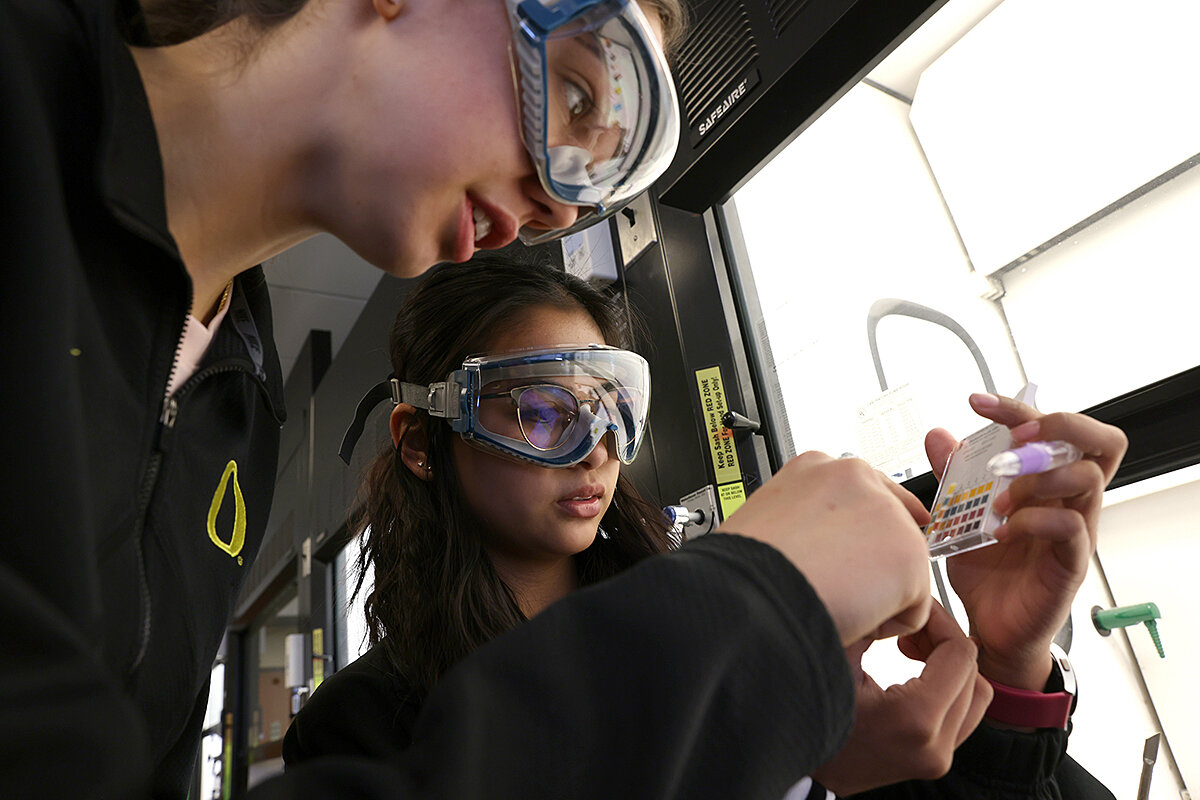These community college classes offer two teachers – and a path to success
Loading...
| EVERETT, Wash.
Terrica Purvis squints through goggles as her hands carefully guide a pipette full of indigo-tinted fluid into clear glass test tubes.
It’s the last chemistry lab of the winter quarter at Everett Community College, and Ms. Purvis is working through the steps of what chemistry faculty member Valerie Mosser jokingly refers to as the post-apocalypse survival lab – an experiment using boiled red cabbage water to test the acidity of common household chemicals.
Ms. Purvis is in her first year of study for an associate degree in nursing at Everett Community College. She is also one of more than 6,000 technical and community college students in Washington enrolled in the state’s Integrated Basic Education and Skills Training (I-BEST) program.
Why We Wrote This
How can community college students master basic skills and prepare for jobs at the same time? Washington state offers a model that supports success – and dignity. The Monitor, in collaboration with six other newsrooms, is examining the challenges facing U.S. community colleges – and potential solutions – in a series called Saving the College Dream.
Students who need extra help in subjects such as algebra struggle to learn if the content is taught in an abstract, isolated manner, educators say. That’s why I-BEST programs feature two teachers in the classroom: one provides job training and the other teaches basic skills in reading, math, or English language.
For Ms. Purvis, who hasn’t been in school for nearly a decade, this class meant getting extra math help right when she needed it: during a chemistry class.
Statewide data shows students in the program graduate at a higher rate than those enrolled in traditional adult basic education.
Among students who started college from 2015 to 2018, an average of 52% enrolled in I-BEST classes earned a degree or certificate within four years compared with 38% of students who did so while enrolled in traditional adult basic education coursework, according to the Washington State Board for Community and Technical Colleges.
The program is so successful that 12 states have implemented or are in the process of implementing an I-BEST model at one or more education institutions.
In the lab, Ms. Mosser bounces between pairs of students, fielding questions about pH measurements and telling them they’ll never know when the skills they’re learning will come in handy.
Each time she gives a lecture or holds a lab, she is joined by co-instructor Candace Ronhaar, who works as a tutor and extra math support instructor for students.
In one session, Ms. Ronhaar lifts a marker to the whiteboard and draws a little heart. She writes the word “mole” beside it and explains it is a unit of measurement equivalent to the amount of atoms contained in 12 grams of carbon-12.
She guides students through practice problems, calculating the molar mass of chemical compounds.
All six students in Chemistry 121 are also taking an entry-level statistics class, and Ms. Ronhaar is co-instructor for both courses. Ms. Mosser says that Ms. Ronhaar’s presence is the most valuable part of the I-BEST model.
“I’m an assessment instructor,” Ms. Mosser says. “She’s just a helping instructor. In the minds of students, the difference is incalculable. They have a different relationship with her. They’re more willing to go to her, because she doesn’t grade them.”
Ms. Purvis, who calls herself a strong student, says chemistry was the first class she ever took that “humbled” her. She doesn’t think she would have passed without I-BEST. Students fresh out of high school had an easier time remembering chemistry and math, Ms. Purvis says, but she hadn’t studied those subjects for 10 years.
“They couldn’t have picked a better second instructor,” Ms. Purvis says of Ms. Ronhaar. “I loved it. We went to her office hours all the time. She even joked around with us.”
After high school, Ms. Purvis spent six years as a cook in the Navy, and took classes at a couple other colleges. Last year, she was medically discharged and returned to school at Everett Community College full time.
After attaining her associate degree in nursing, she plans to transfer to University of Washington Bothell to earn a Bachelor of Science in nursing, and hopes to work in labor and delivery at a hospital.
What the data shows
Helping more students graduate from nursing school by giving them just-in-time math help has a larger societal benefit. From 2020 to 2021, the number of working registered nurses in the United States decreased by more than 100,000 – the highest drop in four decades.
An estimated 200,000 jobs for registered nurses are expected to open each year in the U.S. between now and 2031, the U.S. Bureau of Labor Statistics reported in 2021. That means the job prospects for students like Ms. Purvis are promising.
Not only has I-BEST increased graduation rates, its students turn in solid academic performances. Over the past three years, 90% of students passed their I-BEST courses with a grade of C-minus or better.
The program is growing, and serves a diverse group of students. I-BEST enrollment in the state has increased by more than 20% the past five years. Forty-six percent of students enrolled in I-BEST are students of color, 55% are women, and 39% have dependents.
I-BEST opens the door to federal financial aid by making it available to students who didn’t graduate from high school. Under financial aid rules, students must either have a high school diploma or prove their “ability to benefit” from aid by being enrolled in a qualifying program, such as I-BEST, where they learn basic skills as part of their career pathway.
Along with nursing, other high-demand I-BEST job pathways include aeronautics, manufacturing, and information technologies.
At Bellevue College, I-BEST students enrolled in Business 101 meet with instructor Eric Nacke for an adult basic education class on a separate day. Mr. Nacke teaches English in the context of the business world.
Student Forouzan Barfibafeghi moved from Iran to the U.S. in 2020. She holds a bachelor’s degree in business from Islamic Azad University in Tehran, where she graduated in 1999. Coming back to school in the U.S., Ms. Barfibafeghi says her biggest challenge has been learning English.
She says Mr. Nacke’s classes have not only helped her grow her English skills, they have given her a sense of community.
“Besides teaching just the basic skills to get college-level English,” she says, “This is also a space where we can meet. We have created a strong bond between us. That is one of the highlights for me.”
Although the courses have been held exclusively online via Zoom, Ms. Barfibafeghi says that she has befriended many other students in the class. When she graduates with her associate degree in business, she hopes to find work in the insurance industry.
In the 2021-2022 academic year, 85% of students enrolled in I-BEST classes at Bellevue College were women and 58% were first-generation college students.
Learning in context
I-BEST was launched as a state pilot program almost 20 years ago, when data began to show that students needed vocational training to improve their job prospects. The program was to change the remediation model in most community colleges, where students who don’t do well on placement tests must take pre-college classes in their weak subject – essentially a repeat of high school. Research shows that results of standardized placement tests often correlate with race and socioeconomic status.
The way high school math is taught has not changed much since the 1970s, despite changes in the job market and the way the subject is applied therein, says Davis Jenkins, senior research associate with the Community College Research Center at Teachers College, Columbia University.
“The only purpose of this is to sort by race and class,” Dr. Jenkins says. “And the only reason is people like me – I’m middle class – have known how to work the system. This is bigger than I-BEST. ... We have used Sputnik-era mathematics, abstractly taught, to sort by race and class. Math has revolutionized every industry.”
In Washington, because I-BEST uses a mix of state, federal, and other grant funds, the state doesn’t know how much the program costs. But “they are more expensive than other adult basic education programs because the model calls for two instructors in the classroom,” says state community college spokeswoman Laura McDowell.
The program might be more broadly replicated if it weren’t so costly, she says.
As Ms. Purvis prepares for her next quarter of classes, she says she hopes her future instructors will be as helpful as Ms. Ronhaar.
“She’s my favorite instructor so far since I’ve been going to Everett,” Ms. Purvis says. “We needed her. She had to be there.”
This story, reported by a freelance journalist for The Seattle Times Education Lab, is part of the series Saving the College Dream, a collaboration between The Monitor and journalists at The Associated Press, AL.com, The Dallas Morning News, The Hechinger Report, The Seattle Times, and The Post and Courier in Charleston, South Carolina.









